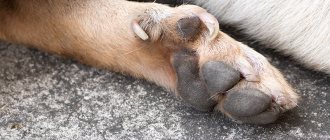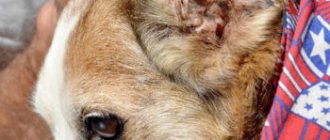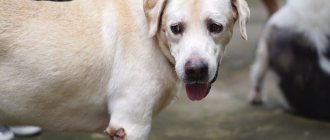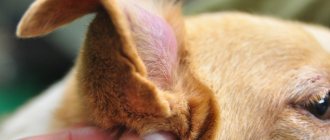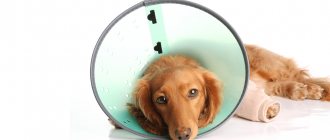It is difficult to find at least one experienced dog breeder who, throughout his entire practice, has never encountered injuries to his pets. Simple wounds received by an animal during careless play or while walking in the forest do not (as a rule) pose any particular danger. It's a different matter if these injuries begin to fester. A purulent wound in a dog is an unpleasant and dangerous pathology, if only because threatens the body with sepsis.
Development mechanism, notes
Everything is quite simple here. If pyogenic microflora gets into an open wound and if the animal is not provided with basic veterinary care, there is every chance of developing purulent inflammation. The younger or older the dog, the higher the likelihood of such an outcome, since in puppies and older dogs the body’s defense system does not work well. Poor nutrition and constant exposure to stress, which greatly weaken the immune system, increase the chances of suppuration.
The pus itself is a mixture of dead microorganisms and dead leukocytes. The latter secrete many lysing (dissolving) enzymes, so that pus has an extremely unpleasant property - it literally dissolves adjacent tissues. It is for this reason that foci of purulent inflammation, if they are located near large vessels, nerve plexuses and other vital organs, are extremely dangerous to the health and life of the dog.
Pus, by the way, can also be different. It is generally classified into two categories: benign and malignant. The first type of pus is thick, greenish-yellow or creamy. The malignant secretion is liquid and pale. Benign pus is called benign because its thick consistency indicates normal immunity (and the fact that it exists at all). The liquid substance directly indicates insufficient production of leukocytes, which may indicate complete depletion of the body’s defense mechanisms.
What should you remember before treating purulent wounds? The most important thing is accuracy. Under no circumstances should pyogenic microflora be allowed to enter the general bloodstream, as this can lead to the development of sepsis . Never try to “squeeze out”, “cut a little”, etc., since such manipulations should only be performed by a qualified specialist! The task of the animal owner should be to evacuate the purulent contents of the wound so that the pus does not melt the adjacent tissue.
By the way, when will you need to resort to the help of a veterinarian urgently? You need to take your dog to a specialist in the following cases:
- The wound smells bad, the animal’s condition is alarming (the pet is lethargic, its general body temperature is elevated, etc.).
- The wound itself is not an open injury, but a closed cavity. This happens when a splinter in the muscles festers; this often happens after dog fights. In this case, the wound channel will need to be expanded and drainage inserted , but the average breeder is unlikely to be able to carry out all these manipulations.
- If the area of the wound is too large. It is quite possible that in this case the remaining tissue will have to be excised, and again only a qualified specialist can handle this.
Treatment of wounds in dogs after a fight
Very often, after fights, dogs are left with wounds. If the wounds are serious, you should immediately contact a veterinarian. But if the wounds are minor, you can treat dog wounds yourself.
It is difficult to find at least one experienced dog breeder who, throughout his entire practice, has never encountered injuries to his pets. Simple wounds received by an animal during careless play or while walking in the forest do not (as a rule) pose any particular danger. It's a different matter if these injuries begin to fester. A purulent wound in a dog is an unpleasant and dangerous pathology, if only because it threatens the body with sepsis. Development mechanism, notesEverything is quite simple here. If pyogenic microflora gets into an open wound and if the animal is not provided with basic veterinary care, there is every chance of developing purulent inflammation. The younger or older the dog, the higher the likelihood of such an outcome, since in puppies and older dogs the body’s defense system does not work well. Poor nutrition and constant exposure to stress, which greatly weaken the immune system, increase the chances of suppuration. The pus itself is a mixture of dead microorganisms and dead leukocytes. The latter secrete many lysing (dissolving) enzymes, so that pus has an extremely unpleasant property - it literally dissolves adjacent tissues. It is for this reason that foci of purulent inflammation, if they are located near large vessels, nerve plexuses and other vital organs, are extremely dangerous to the health and life of the dog. Pus, by the way, can also be different. It is generally classified into two categories: benign and malignant. The first type of pus is thick, greenish-yellow or creamy. The malignant secretion is liquid and pale. Benign pus is called benign because its thick consistency indicates normal immunity (and the fact that it exists at all). The liquid substance directly indicates insufficient production of leukocytes, which may indicate complete depletion of the body’s defense mechanisms. What should you remember before treating purulent wounds? The most important thing is accuracy. Under no circumstances should pyogenic microflora be allowed to enter the general bloodstream, as this can lead to the development of sepsis. Never try to “squeeze out”, “cut a little”, etc., since such manipulations should only be performed by a qualified specialist! The task of the animal owner should be to evacuate the purulent contents of the wound so that the pus does not melt the adjacent tissue. By the way, when will you need to resort to the help of a veterinarian urgently? You need to take your dog to a specialist in the following cases:
Cleanliness is the key to healthTo ensure proper cleanliness around the wound, you need to carefully trim all the fur around it. In the end, hair stuck together from pus is a good environment for microorganisms that lead to the development of inflammation and maceration of the skin. In addition, it is much more convenient to apply bandages to a clean wound area. What else do you need to remember when treating dogs at home? If the wound is already running, and the area around it looks like one big, untidy lump of hair stuck together with pus, you will have to work hard. Carefully cut off all the tangles and remove the dried exudate using a cotton-gauze swab moistened with hydrogen peroxide. Try not to press too hard: if the dirt does not give way, just moisten it well with peroxide and wait until everything gets wet. If there are any foreign bodies in the wound (dirt, wool, wood chips), try to carefully remove them. You don’t need to use your fingers for this; it’s better to use tweezers (preferably clean ones). When the object is too large and goes deep into the wound, do not touch it at all, but immediately take your pet to the veterinarian. Now we’ll tell you how you can treat a purulent wound on a dog. Applying bandagesDo not under any circumstances fill the wound with iodine or brilliant green! This will only make things worse. It’s also not worth getting into the wound itself and scraping out pus from there. You can wash it with a solution of Farmoxidine and the same peroxide (not “stronger” than a 3% solution). This should be done two to three times a day. Tampons soaked in Vishnevsky's balsamic liniment, levomekol or Shostakovsky's balm are applied to the wound itself. From above, all this is fixed with a bandage or plaster. You can also sprinkle the wound surface with streptomycin. Important! Never completely wrap festering wounds or cover their surface with film! Such damage must be in contact with oxygen from the air, which prevents the development of anaerobic microflora. In almost all cases, antibiotics are prescribed. For purulent wounds in dogs, cephalosporin drugs have proven themselves to be effective. They are dissolved in a 0.5% solution of novocaine and the resulting solution is used to puncture the damage around the perimeter. In severe cases, it is also advisable to administer broad-spectrum drugs intravenously, as this prevents the development of septic lesions. If the wound is even hypothetically within the reach of the dog's paws and tongue, a surgical collar is definitely (!) needed. Until the damage heals completely and stops bothering your pet, he should wear it constantly. Otherwise, all treatment of purulent wounds in dogs will be ineffective (if the dog scratches and licks the wound). |
Immediately upon arriving home, treat the wound with any alcohol-containing composition. If the wound is not deep, it will heal within a few days.
Treatment of lacerations in dogs. But there are wounds in the form of holes in a dog’s skin left by fangs. Such wounds very often begin to fester. When contacting a veterinarian, the doctor prescribes antibiotic injections to relieve inflammation. While the antibiotic reaches the affected area through the blood, it can have a bad effect on the health of the dog’s liver. Especially if treatment is prescribed for a long time and with strong antibiotics.
To treat such wounds in dogs at home and without causing significant harm to her health, you will need: an alcohol solution or vodka, a dry antibiotic (I always use bicillin or penicillin), and streptocide powder. These drugs can be bought at any pharmacy and are not very expensive.
First you need to trim the hair around the wound. Then squeeze the pus out of the wound, cleaning it as cleanly as possible. Then pour an alcohol solution or vodka into the wound to disinfect it. After cleaning and disinfection, you need to pour a dry antibiotic into the wound. And sprinkle streptocide on top of it all, so that a crust forms on the wound and the antibiotic does not leak out of the wound, and to protect the wound from external microbes. Do not skimp on streptocide, you need it to form a good crust on the wound.
Cleaning and antibiotic treatment of a dog's wound should be carried out 2 times a day until the inflammation is relieved. After the wound stops festering, you can wash it with alcohol once a day and cover it with streptocide without an antibiotic until it heals completely.
mireyka.ru
Cleanliness is the key to health
To ensure proper cleanliness around the wound, you need to carefully trim all the fur around it. In the end, hair stuck together from pus is a good environment for microorganisms that lead to the development of inflammation and maceration of the skin. In addition, it is much more convenient to apply bandages to a clean wound area. What else do you need to remember when treating dogs at home?
If the wound is already running, and the area around it looks like one big, untidy lump of hair stuck together with pus, you will have to work hard. Carefully cut off all the tangles and remove the dried exudate using a cotton-gauze swab moistened with hydrogen peroxide. Try not to press too hard: if the dirt does not give way, just moisten it well with peroxide and wait until everything gets wet.
If there are any foreign bodies in the wound (dirt, wool, wood chips), try to carefully remove them. You don’t need to use your fingers for this; it’s better to use tweezers (preferably clean ones). When the object is too large and goes deep into the wound, do not touch it at all, but immediately take your pet to the veterinarian. Now we’ll tell you how you can treat a purulent wound on a dog.
How to treat wounds in animals
The main health hazard is lacerations in dogs. Typically, such a lesion does not heal quickly and often has undesirable consequences. Treatment of such a pathology, as a rule, requires surgical measures, because without this, pus and tissue particles that are semi-decomposed quickly accumulate in the wound, and a purulent wound in dogs is formed.
It is generally accepted that with this type of injury one should not worry only when it is minor (no more than 2 cm long, 1 cm deep). More serious cases always require immediate medical attention. It is especially needed when the pet’s wound begins to fester. At home, the animal should treat the affected area with hydrogen peroxide, pre-cut the hair, remove pus and dirt. And then the action is up to the specialists.
A drainage system will be installed in the animal clinic to help remove purulent discharge, which is not removed until the wound is completely cleaned and the inflammatory process is stopped. An antibiotic is always used in the form of injections for dogs for purulent wounds. This can be Biomycin, Terramycin, Gramicidin, etc. At the same time, wipes soaked in a solution that promotes the removal of exudate are applied to the wounded area. If the wound is serious enough, it is stitched up, but treatment is also prescribed. As a rule, antibiotics with a wide spectrum of effects are used, and in high doses.
It happens that hormonal drugs are also prescribed, although when treating complex lesions, when the treatment period lasts 2-3 weeks, such a prescription is not recommended. But vitamin complexes will come in handy here. After all, with their help you can improve metabolism, accelerate the production of leukocytes, and strengthen the animal’s body’s defenses. Often, tampons with Vishnevsky balm are applied to such wounds.
Applying bandages
Do not under any circumstances fill the wound with iodine or brilliant green! This will only make things worse. It’s also not worth getting into the wound itself and scraping out pus from there. You can wash it with a solution of Farmoxidine and the same peroxide (not “stronger” than a 3% solution). This should be done two to three times a day. Tampons soaked in Vishnevsky's balsamic liniment, levomekol or Shostakovsky's balm are applied to the wound itself. From above, all this is fixed with a bandage or plaster. You can also sprinkle the wound surface with streptomycin.
Important! Never completely wrap festering wounds or cover their surface with film! Such damage must be in contact with oxygen from the air, which prevents the development of anaerobic microflora.
In almost all cases, antibiotics . For purulent wounds in dogs, cephalosporin drugs have proven themselves to be effective. They are dissolved in a 0.5% solution of novocaine and the resulting solution is used to puncture the damage around the perimeter. In severe cases, it is also advisable to administer broad-spectrum drugs intravenously, as this prevents the development of septic lesions.
What is a wound on a dog?
In order to provide emergency assistance and to develop subsequent actions for treating a pet, each owner must be able to assess the nature of the wound, its size, the depth of the lesion, the presence of bleeding and its intensity. The main types of injuries are:
Abrasions (scratches), splinters - damaging the top layer of skin, provoking a slight inflammatory process on it and barely noticeable bleeding, the formation of bruises. This can happen for any reason: from the owner’s inept handling of the leash to the dog touching various objects and plants, active scratching, etc. Such injuries are simple and do not require going to a veterinary clinic, but can be treated at home;
Lacerations, which also include cuts, are the result of deeper damage to the animal’s skin. The reasons for this can be different, but the cut itself can be smooth, clean and shallow or deep, when the edges do not have a clear outline (torn) and all layers of the skin are affected, right down to the muscle tissue;
Puncture wounds and bites are dangerous due to the possibility of rapid bacterial infection. These wounds, especially small ones, are difficult to immediately identify, and if therapeutic and disinfecting measures are not taken in a timely manner, they quickly become inflamed and cause suppuration. Such purulent wounds in dogs require immediate treatment;
Injuries are the most complex and life-threatening injuries. Occurs as a result of beatings, accidents, accidents.
When to see a veterinarian
Home treatment for all types of wounds is indicated only when the animal has received a superficial injury that does not pose a threat to its life. In other cases, it is necessary to show your pet to a veterinarian. This should not be neglected if:
- this is a bite - the animal that caused such an injury may be sick, in particular with rabies, which is dangerous not only for the life of the pet itself, but also for members of the entire family;
- The dog’s wounds do not heal - only a specialist can determine the reason for this; the animal is severely injured - any delay in this case may cost its life;
- severe bleeding, especially that cannot be restored;
- an extensive wound on the head, a fracture, or other cases requiring special treatment methods or the use of potent drugs.
How to treat a dog's wound yourself
If an injury is detected in a furry pet, the owner must provide emergency assistance. Veterinary experts recommend performing the following independent manipulations:
- Using blunt-tipped nail scissors, trim the hair around the wound. The procedure is performed on both short-haired and long-haired breeds of animals.
- Using a clean napkin, bandage or gauze, remove foreign objects that have entered the wound (dirt, sawdust, pieces of metal, brick, hair, etc.).
- In case of heavy contamination, the surrounding skin should be thoroughly washed with a soap solution that helps quickly soften dried dirt and blood.
- If there is bleeding from the wound, measures must be taken to eliminate it. For this purpose, 3% hydrogen peroxide is used. The product interacts with the blood, forming air bubbles. This can frighten the animal, so the dog should be encouraged, petted or distracted before manipulation.
- After the bleeding has stopped, it is necessary to begin treating the wound itself. For this purpose, veterinarians recommend using hydrogen peroxide, a solution of Chlorhexidine, Furacilin, Miramistin.
- To disinfect the wound canal with antiseptic solutions, it is convenient to use gauze wipes and a rolled bandage. In the field, you can use a clean scarf or piece of cotton fabric.
- A small amount of anti-inflammatory ointment must be injected into the wound using a syringe without a needle. For this purpose, chloramphenicol or streptomycin ointment, Levomekol, is suitable.
- The wound can be sprinkled with streptocide powder.
- After treatment, the wound surface must be covered with gauze. This will help reduce the risk of infection and promote longer retention of drugs in the pathological focus.
- The dog should not be allowed to lick or injure the wound with its limbs. For this purpose, a bandage is applied or a special collar is put on the animal’s neck, which prevents the pet from harming itself.
Self-treatment of a wound does not in any way exclude a visit to a specialized institution with your furry pet.
How to treat a dog's wound
Anyone who has decided to take responsibility and get a dog, no matter whether it is a large shepherd dog or a tiny Yorkshire terrier, should have a home first aid kit in the house with a set of medical supplies that can be used to provide first aid to the animal, treat wounds and treat injuries. that do not require veterinarian intervention. First of all, these are bandages, antibacterial patches, a tourniquet to stop bleeding, a set of disinfectants and healing ointments.
When a dog is injured, the first thing you need to do is not get confused. If the bleeding is severe, then you need to apply a tourniquet above the wound area as quickly as possible - it is not advisable to keep the tourniquet for more than 2-2.5 hours (if it is impossible to apply a tourniquet, the bleeding can be stopped with a tight bandage). The wound must be quickly treated with disinfectants: chlorhexidine, miramistin or terramycin aerosol. During disinfection, using a gauze swab or cotton pad, you need to remove dirt and other foreign particles from the wound (you can also use tweezers). Trim the hair around the wound with scissors so that the hairs do not fall on the injured surface or carefully shave with a safety razor. Then treat the wound with hydrogen peroxide, which will help stop bleeding from small vessels. And then assess the severity of the wound. If it is a scratch, abrasion, bruise with a small surface of soft tissue injury, a splinter or an incised wound, no more than 2-3 centimeters long and no more than a centimeter deep, then such wounds can be cured at home. If the dog’s wound is large or deep, its edges are torn, you suspect that tendons or internal organs may be injured, then after treating the wound and applying a bandage, the animal should be urgently taken to the veterinarian.
Treatment of inflamed formation
Treatment of a purulent wound requires professional intervention, since infection increases the risk of developing sepsis in a sick animal.
You should definitely contact a veterinarian if your dog refuses to eat, is lethargic, or has an elevated body temperature.
Therapeutic measures include surgical cleansing of the wound from purulent exudate, the use of antiseptics, antibacterial and restorative drugs, and installation of drainage. Sutures are not used for symptoms of purulent inflammation.
Cleansing the wound
An important condition for successful treatment of a wound with a purulent process is its cleansing. For this purpose, the animal undergoes surgical manipulation in a veterinary clinic. Under local anesthesia, the wound channel is opened, necrotic tissue is excised, and purulent exudate is removed.
During the procedure, the purulent pockets are opened and cleansed. Manipulation, as a rule, is accompanied by infiltration anesthesia with a solution of novocaine with an antibiotic.
After surgical cleaning of the wound, the veterinarian treats the tissue with antiseptic solutions. For this purpose, use a 3% solution of potassium permanganate and a 0.1% solution of Rivanol, similar to hydrogen peroxide. An effective remedy for the antiseptic treatment of purulent wounds is a 2% solution of Chloramine and a 0.5% solution of Chlorhexidine.
Useful video
For information on how and what to treat a wound, watch this video:
In veterinary practice, dogs and other pets are diagnosed with puncture, cut, and purulent wounds. They are characterized by a violation of the integrity of the skin, mucous membranes, tissues of internal organs, and the development of inflammatory processes in various structures of the dermis. Such damage occurs as a result of mechanical damage (impacts, cuts), thermal, chemical exposure, and bites from relatives and other animals. Surgical wounds occur after abdominal operations or surgery.
Purulent wounds
All wounds except operating wounds are infected. That is, pathogenic flora penetrates into the damaged area. For example, bite wounds are almost always contaminated with pathogenic agents. Under favorable conditions, microorganisms actively multiply quite quickly, provoking acute inflammation.
As a rule, the appearance of purulent wounds in dogs is promoted by: Klebsiella, Pseudomonas aeruginosa, Escherichia coli, streptostaphylococci. During their life, bacteria produce endotoxins, which not only destroy tissue and provoke inflammatory processes in the deep structures of the dermis, but also poison the entire body of the pet.
Types of wounds in dogs
Scratches and abrasions. Occurs most often in dogs. Dogs can get scratches and abrasions not only during walks, colliding with thorny plants or wires, but also during fun games in an apartment or house. Most often, the paws and sides of the dog suffer from abrasions and scratches.
Splinters. Although a splinter can cause anxiety for a dog, this type of wound is the least dangerous. Dogs' paws most often suffer from foreign objects after walks, and often the tongue if the pet likes to actively chew wooden objects.
Cuts. Sharp glass is the main enemy of dog paws during walks. Cuts can be superficial or deep, so you need to be very careful when handling this type of wound.
Bite wounds . Bites from other dogs or cats pose a serious danger to the dog not only because of their severity - sharp fangs can tear tendons and large blood vessels - but can also cause serious infection of the wound, because the saliva of other animals contains bacteria that are harmful to your pet.
Stab and cut wounds . Deep wounds inflicted on the dog by objects with long sharp surfaces. They can penetrate deep into the animal’s body, causing serious blood loss and damage to internal organs.
Lacerations. The danger of lacerations is that they can seriously damage tendons and soft tissues, and the uneven edges of the wound will fuse and heal for quite a long time.
Bruised wounds . Dogs can get them in collisions with cars, other heavy objects, or from being hit with a stick. With such wounds, the skin and soft tissues of the animal’s body are crushed, blood vessels are seriously injured, and an extensive hematoma occurs.
First aid
Faced with a similar situation before the veterinarian arrives or travels with the pet to the veterinary clinic, it is very important to prevent infection and prevent the development of the inflammatory process. If the damage is quite extensive and dirty, first of all, wash the affected area with plenty of warm water and laundry soap.
At the next stage, use sterile tweezers to try to remove foreign particles that have entered the wound. Carefully trim the fur around the affected area with sterile scissors. Treat the skin around the purulent wound with brilliant green, alcohol tincture of iodine, using disposable gauze and cotton pads. A short novocaine-antibiotic block is administered. Partial excision of dead tissue may be necessary, followed by drainage of the wound. Conducted in a veterinary hospital.
To wash wounds, you can use any aseptic means: a weakly concentrated 3% solution of potassium permanganate, furatsilin, chlorhexidine, propolis tincture, calendula, plantain decoction, and other medicinal plants.
Important! If the wound has been sutured, the seams are treated daily with disinfectant solutions for five to seven days.
Wound healing preparations (solcoseryl, actovigin, vinylin, Levomikol) are applied to a clean wound. In severe advanced cases, to prevent the development of infection or if the wound is already infected, local bactericidal, anti-inflammatory drugs (ointments, creams, pharmaceutical mash), and complex antibacterial agents must be used. After treatment, the wound is covered with a sterile bactericidal plaster and a bandage is applied.
Antibiotics for animals with purulent wounds
A course of antibiotic therapy for purulent open wounds should be prescribed by a veterinarian. In complex therapy for four-fingered patients, antibiotics of the penicillin, cephalosporin, tetracycline series, ampicillins, and macrolides are prescribed orally to prevent infection. Therapeutic therapy for purulent wounds should also be selected taking into account the phases of the wound process.
Antibiotics are selected based on the results of microbiological tests and bacteriological studies aimed at determining the sensitivity of pathogenic flora to certain drug substances. Additionally, in the initial stages of treatment of purulent wounds in dogs, pharmacological anesthetics are used.
For local treatment, a good wound healing effect is noted after the use of antibacterial ointments, gels, and creams. Dogs are prescribed:
- Levomikol.
- Liniment Syntomycin 5%.
- Tetracycline 3% ointment.
- Ranosan.
- Betadine.
- Safroderm-gel.
- Sangel.
- Gentamicin ointment.
- Septogel.
The above listed pharmacological agents have a pronounced bactericidal effect, relieve swelling, prevent degenerative-destructive processes in tissues, and accelerate regeneration processes. Used for the treatment of pustular lesions of soft tissues, furunculosis, purulent abscesses in animals, in the presence of open wounds infected with pyogenic flora.
Review of drugs
Antibacterial drugs for dogs and other pets should be prescribed by the attending veterinarian, having in hand the results of diagnostic examinations. The same applies to the duration of the treatment course, dosage, and frequency of administration. If the veterinarian has prescribed the dog to take the drug for seven days, twice a day, be sure to follow the course, even if the clinical symptoms have stopped and the pet has begun to recover.
Antibiotics, the course of treatment for dogs must be prescribed by a veterinarian
Important! Uncontrolled use of antibiotics can cause serious complications in a pet’s body. If the dosage is not observed, if it is exceeded, side symptoms may appear; if it is decreased, the effect in treatment will be minimal.
Antibacterial drugs are classified according to their principle of action into:
- bacteriostatic, which prevent further proliferation of pathogenic flora;
- bactericidal, the action of medications is aimed at destroying viruses and bacteria.
Antibacterial therapy is selected individually, in each specific case. Despite the fact that most modern antibiotics are universal and have a complex, wide spectrum of action, before a veterinarian prescribes a medicine, a series of microbiological and bacteriological tests are performed that will help determine the sensitivity of bacterial agents to certain components of antibacterial agents.
The most effective complex antibiotics for dogs, according to veterinarians, include:
- Tsiprovet.
- Betamox.
- Amoxicillin.
- Marfloxacin.
- Noroclav (Britain).
- Baytril.
- Ceftriaxone.
- Gentamicin.
- Engemicin.
- Amoxicillin.
- Triprim.
- Sinulox.
- Terramycin (USA).
Domestic and imported antibacterial drugs with a wide spectrum of action that are used to treat dogs can be purchased in pharmacies, veterinary clinics, and veterinary pharmacies in your city. Antibacterial drugs are available in the form of tablets, injection solutions, ointments, liniments, gels, ophthalmic, intranasal, and ear drops.
Tsiprovet
Ciprovet is available in the form of eye drops and tablets. Drops are used to treat ophthalmological diseases of viral and bacterial etiology in dogs - purulent, catarrhal, serous, allergic conjunctivitis, uveitis, blepharitis, and corneal ulcers.
Ciprovet – eye drops for dogs
Ciprovet tablets are prescribed to dogs for treatment of viral bronchitis, pneumonia, and bronchopneumonia. The antibiotic helps eliminate the symptoms of acute and chronic diseases of the genitourinary system and gastrointestinal tract. Used to treat bones, joints, soft tissues, as well as in the case of secondary infections complicated by bacterial flora.
Ciprovet is a safe, most effective antibacterial agent with complex action. The active components kill most types of dangerous pathogens that parasitize the dog’s body.
Ciprovet tablets for dogs are not recommended to be given to pregnant, lactating females, growing puppies, or animals with congenital or acquired chronic pathologies of the central nervous system. Do not use in therapeutic therapy for hypersensitivity to the components of the drug, in particular to fluoroquinolones.
Ciprovet tablets for animals
Amoxicillin
A universal antibacterial drug with complex action, which is aimed at suppressing the activity and destroying various groups of viruses and bacteria. Well tolerated by dogs and other warm-blooded animals. In rare cases, it causes side effects. Produced in the form of tablets, sterile suspensions for injection.
Effective in the treatment of diseases of the gastrointestinal, respiratory tract, acute, chronic pathologies of the genitourinary system, and other systemic diseases of viral etiology.
Amoxicillin
In veterinary practice, dogs are prescribed for:
- leptospirosis;
- infectious rhinitis, bronchitis;
- endometritis, cystitis;
- hepatitis;
- gastroenteritis.
The injection solution is administered intramuscularly at a dosage of 1 ml per 10 kg of animal weight. The dosage of the drug in tablets is calculated similarly. Amoxicillin can also be given intravenously. Do not prescribe if the animal’s body is hypersensitive to the active ingredients, simultaneously with other antibiotics of the penicillin group.
Marfloxin
The antibacterial drug is presented in the form of pills for oral use and in the form of a sterile solution for injection. Belongs to the group of fluoroquinolones. It has a pronounced bactericidal effect and is active against gram-positive and gram-negative microorganisms. Used in therapeutic therapy for soft tissue infections, diseases of the urinary system, respiratory diseases, and for the treatment of wounds infected with bacterial flora.
The antibiotic should not be used for puppies, young dogs under one year of age, dogs with central nervous system lesions, or those with hypersensitivity to the active components of the drug. Do not prescribe simultaneously with cationic medications.





